Nursing Diagnoses Of Patients With Neurological Disorders In Ward
(1) Universitas Islam Sultan Agung
(*) Corresponding Author
Abstract
Keywords
Full Text:
PDFReferences
Abubakar, S.A. & Jamoh, B.Y. (2017). Dysphagia following acute stroke and its effect on short-term outcome. Nigerian Postgraduate Medical Journal;24(3):182-186. doi: 10.4103/npmj.npmj_96_17.
Ackley et al. (2017). Nursing diagnosis handbook, an evidence based guide to planning care.11th Ed.St.Loius: Elsevier
Chaves, D.B.R., Costa, A.G.S., Oliveira, A.R.S., Silva, V.M., Araújo, T.L.,& Lopes, M.V.O. (2013). Comunicação verbal prejudicada - in- vestigação no período pós-acidente vascular encefálico. Rev RENE;14(5):877-85
Costa, A.G.S., Oliveira, A.R.S., Alves, F.E.C., Chaves, D.B.R., Moreira, R.P., & Araujo, T.L. (2010). Nursing diagnosis: impaired physical mobility in patients with stroke. Rev Esc Enferm USP. 44(3):753-8.
Christensen, P. J., & Kenney, J. W. (2009). Proses Keperawatan Aplikasi Model Konseptual. (Y. Yuningsih & Yasmin Asih, Eds.1). Jakarta: EGC.
Dehaghani SE, Yadegari F, Asgari A, Chitsaz A, Karami M. (2016). Brain regions involved in swallowing: Evidence from stroke patients in a cross-sectional study. Journal of Research in Medical Science;14;21:45.
Dongoes, M.E., Moorhouse, M.F., & Murr, A.C. (2013). Nursing diagnosis manual plannning, individuliting and documentating clienr care. 4th Ed. Philadelphia: F.A Davis Company
Hickey, J. V. (2014). The Clinical Practice of Neurological and Neurosurgical Nursing (7th ed.). Philadelphia: Lippincot Williams & Walkins.
Kwak et al.(2018). Influence of Nasogastric Tubes on Swallowing in Stroke Patients: Measuring Hyoid Bone Movement With Ultrasonography. Annals of Rehabilitation Medicine; 42(4): 551–559. doi: 10.5535/arm.2018.42.4.551
Ishida, R., Palmer, J,B.,& Hiiemae, K.M. (2002). Hyoid motion during swallowing: factors affecting forward and upward displacement. Dysphagia;17:262–72.
Marian et al. (2017). Measurement of Oxygen Desaturation Is Not Useful for the Detection of Aspiration in Dysphagic Stroke Patients. Cerebrovasc Dis Extra;7(1):44-50. doi: 10.1159/000453083.
Oliveira, A.R.S., Costa, A.G.S., Moreira, R.P., Cavalcante, T.F.,& Araujo, T.L. (2012). Diagnósticos de enfermagem da classe ativi- dade/exercício em pacientes com acidente vascular ce- rebral. Rev Enferm UERJ;20(2):221-8.
Otto, D.M., Ribeiro, M.C, Barea, L.M., Mancopes, R., & Almeida, S.T. (2016). Association between neurological injury and the severity of oropharyngeal dysphagia after stroke. Codas;28(6):724-729. doi: 10.1590/2317-1782/20162015139.
Article Metrics
Abstract view : 3339 timesPDF - 89 times
DOI: https://doi.org/10.26714/mki.1.3.2018.7-11
Refbacks
- There are currently no refbacks.
Copyright (c) 2018 Suyanto Suyanto

This work is licensed under a Creative Commons Attribution 4.0 International License.
This journal is indexed by:
Kedungmundu Raya No. 18 Semarang NRC Building Universitas Muhammadiyah Semarang
Phone: 02476740287
Fax: 02476740287
Email: [email protected]





















